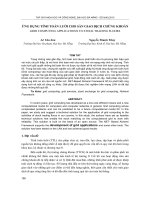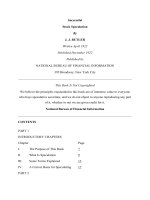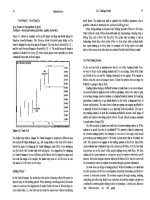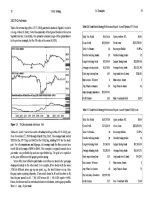Successful Stock Trading pdf
Bạn đang xem bản rút gọn của tài liệu. Xem và tải ngay bản đầy đủ của tài liệu tại đây (2.2 MB, 64 trang )
1
This extract from Adaptive Analysis for Australian Stocks by NickRadge was
first published in 2006 by Wrightbooks. Extract has been updated and
published in 2012 by Radge Publishing.
© Nick Radge 2012. All rights reserved. You may copy, distribute and
transmit this material in its original format. You may not alter, transform
or build upon this work.
Radge Publishing
PO Box 721 Noosa Heads QLD 4567 Australia.
www.radgepublishing.com
ISBN: 9780980871241 (EBook)
Cover design: Zach Radge
Disclaimer:
The material in this publication is of the nature of general comment only and does not
represent professional advice given by the publisher. It is not intended to provide specific
guidance for your particular circumstances and it should not be solely relied upon as the
basis for any decision to take action or not take action on any matter for which it covers.
While the Author is a licensed financial professional, the publisher advises readers to
obtain professional advice where appropriate and which considers your exact situation,
before making any such decisions. The publisher makes no representation or warranties
with respect to the accuracy, applicability, fitness, or completeness of the contents.
EVERY EFFORT HAS BEEN MADE TO ACCURATELY REPRESENT THIS METHOD AND ITS
POTENTIAL. THERE IS NO GUARANTEE THAT YOU WILL EARN ANY MONEY USING THE
TECHNIQUES AND IDEAS IN THIS EBOOK. EXAMPLES IN THIS EBOOK ARE NOT TO BE
INTERPRETED AS A PROMISE OR GUARANTEE OF EARNINGS. EARNING POTENTIAL IS ENTIRELY
DEPENDENT ON THE PERSON. THE PUBLISHER DOES NOT PURPORT THIS AS A ‘GET RICH
SCHEME’. ALL COMMENTS AND/OR METHODS PRESENT ARE NOT SPECIFICALLY ENDORSED OR
PROMOTED DIRECTLY BY THE PUBLISHER AND ANY LIABILITY RELATING FROM SUCH IS HEREBY
WAIVED AGAINST THE PUBLISHER.
2
Important Information
This book may contain advice that has been prepared by Reef Capital
Coaching (AFSL 288200). Being general advice it does not take into
account your objectives, financial situation or needs. Before acting on this
general advice you should therefore consider the appropriateness of the
advice in regard to your situation. We recommend you obtain financial,
legal and taxation advice before making any financial investment
decisions.
This material has been prepared based on information believed to be
accurate at the time of publication. Subsequent changes in circumstances
may occur at any time and may impact the accuracy of the information.
Past results are not a reliable indication of future performance.
All results are considered to be hypothetical unless otherwise specified.
Hypothetical performance results have many inherent limitations. Unlike
an actual performance record, simulated results do not represent actual
trading. Also, since the trades have not actually been executed, the results
may have under or over compensated for the impact, if any, of certain
market factors, such as lack of liquidity.
3
Contents
INTRODUCTION 4
CHAPTER 1 - AIMS 7
CHAPTER 2 - SKEWING THE NUMBERS TO WIN 20
CHAPTER 3 - ENTRIES, FREQUENCY AND MIND-SET. 31
CHAPTER 4 - RISK MANAGEMENT 43
CONCLUSION AND FURTHER READING 56
BONUS: FREE 2 week trial to The Chartist 57
APPENDIX A - STOPS AND LONG TRADING 58
APPENDIX B - STOPS AND SHORT TRADING 61
4
INTRODUCTION
This e-book is designed to show you an alternative way of looking at
profitability and your own trading. My reputation in the retail marketplace
is as a specialist in risk management and systematic trading strategies.
While systematic trading may sound complicated to the new trader, it
simply means a strategy that is defined by very specific rules – rules to
define the trend, enter and the market and manage risk. This is the way I
have always traded and I am happy to share my insights into trading the
global markets.
I deal with technical analysis rather than fundamental analysis. It's my
belief that the picture of a stock's current price action and price history
cannot be disputed – it is a 100 per cent certainty. A company's balance
sheet, earnings and disclosures, however, can be disputed. Bear Sterns,
Lehman Brothers, MF Global and Enron are some better known and recent
examples where many fundamental analysts got it plain wrong and,
unfortunately, investors paid the price for the poor analysis. Other
examples are just as bad and I collected a huge number of examples in the
early 2008 deluge of earnings downgrades. We can see the same trend of
poor disclosure throughout the world. While an in-depth look at all of
these examples is beyond the scope of this book, suffice to say I believe
the reliance of many analysts on company disclosures is questionable.
I readily accept that the application of both types of analysis is equally
subjective. In order to establish a fair valuation for a stock, a fundamental
analyst must make assumptions on future earnings growth and other
contributing factors, such as the expected period of growth, non-growth
periods and benchmark interest rates. Once these assumptions have been
plugged into analysts' models, the resulting valuations vary considerably.
These valuations are easily accessible by reviewing consensus data.
However, the same applies for the technicians. The way one pattern is
5
read can vary among analysts. In this area, I see technical analysis and
fundamental analysis standing side by side.
However, the main benefit of technical analysis over fundamental analysis
is that the charts provide a very specific right or wrong point where
protective stops can be placed and monetary losses can be limited. As
you'll see shortly, the limitation of losses is paramount to the success of a
trader and an investor, both financially and psychologically.
People may be forewarned of situations such as the collapses of Bear
Sterns and Enron by the deteriorating price action. Knowing when one is
wrong using fundamentals, though, is a very grey area. Depending on the
style of analysis employed, the lower a share price goes below its
valuation may mean the better value the stock becomes. On the other
hand, it may mean the valuation was incorrect to begin with. It's a hard
ask for any analyst to amend his or her analysis and valuation in the face
of a plunging share price – they are usually only forced do so after the fact
and after the monetary damage is done.
At the time of writing, I've been trading and investing since 1985, a total of
26 years, or just over half my lifetime. I have personally traded many
global instruments; from stocks to bonds, from commodities to foreign
exchange and ETFs. In the early 1990s, I worked in the pits of the Sydney
Futures Exchange. Later, in the mid-1990s, I worked in dealing rooms in
London and Singapore before starting a hedge fund in 1998. In 2001, with
advancing regulatory conditions, I decided to move to another investment
bank where I became an associate director and managed accounts using
systematic trading approaches built around technical analysis.
It was in the day-to-day dealing with retail clients that I realised the
extreme psychological factors that play havoc with their decisions. The
need to almost always be correct, the inability to realise when analysis is
wrong and then to take the appropriate action to defend an account, the
fear of losing money, the over-reliance on unproven theories, or any
6
mundane theory for that matter – all are products of psychology, and the
list goes on. However, one factor clearly stood out above all others to
create the most havoc – not understanding that profits can be generated
regardless of what tools or analysis are used.
This ebook is about understanding how to make profits.
As we've moved further into the era of self-managed capital and personal
responsibility for one's own financial affairs, it has always been
pleasurable to hear how my analysis has made at least a small difference.
On a final note, remember – there is more to life than trading. The
markets and the opportunities found within them will always be there
tomorrow.
Nick Radge
www.thechartist.com.au
7
CHAPTER 1 - AIMS
Your aim is to be profitable.
My aim is to help you understand how to make yourself profitable.
There may not appear to be a profound difference in the above
statements, but let's remember that the vast majority of traders, and
active investors for that matter, are losers – or, at best, marginal winners.
Some people pay educators up to $20000 to help them find an edge or the
secret to generating profits in the markets. They listen to poor advice,
perhaps from non-licensed practitioners, and rarely take any responsibility
for their own actions. If you are like many other beginners, you probably
already feel as though you've been through the ringer, trying many
different methods and reading any book you could get your hands on. I
call this the beginner's cycle – moving back and forth between methods
and ideas that just never eventuate into any concrete or consistent profits.
It can be an expensive and long journey but, more importantly, it's an
extremely frustrating journey that causes many to give up.
While finding a trading or investing style that suits you is important, it is
more important to understand and accept why profitability occurs. I say
'accept' because what I put forward here is usually dismissed for
simplifying a so-called complex concept. But simple works through thick
and thin, good and bad. (Of course, psychology is also extremely
important; however, as I am not an expert in that field, I won't be
exploring that side of the equation in too much depth.)
What I would like to do is to realign the thinking processes that most likely
operate within you. To start with I'll work through a few issues and
hopefully get you thinking differently about them. What I'd like you to do
as you read through is ask questions of yourself and those in the trading
community you may have come in contact with. Rather than simply
8
agreeing or disagreeing with my points, see if you can actually relate to
them and understand the consequences of my arguments. Trading is
about opening your mind to possibilities. After 26 years in the markets I
am still learning, still researching and still passionate. Passion is the most
important thing to develop – from there, profitable trading will flow to
you.
Trading tools and indicators
If we placed 100 consistently profitable traders in a room and asked each
to discuss his or her trading style and techniques in five sentences or less,
in my experience, whilst each person would use different tools and styles,
they would all be trying to achieve the same goal – that is, to generate
profits.
Every time you speak with another trader (regardless of whether he or she
is successful), every time you read a trading book, every time you receive
advice, there will always be new information to take in – usually about an
entry technique, or a new style, method or indicator. Everyone has an
opinion. There are many successful traders – or at least people who have
had just one profitable trade – and they have achieved this success even
though they all use different tools and techniques.
Out of our sample of 100 consistently profitable traders, 40 may use
fundamental analysis, 40 may use technical analysis and 20 may just use
intuition or gut feel. Even then, the 40 who use fundamental analysis may
use different aspects of that field. Some may rely on various ratios, while
others may not take any ratios into account and rely solely on insider
activity. The list and combinations are infinite.
Of the technical traders, some will rely on moving averages, some on an
RSI or other indicator, while others will rely only on price patterns and
volume. Yet again, the pieces to the puzzle can be infinite. My point is that
each profitable trader will use a different technique, style, investment
9
time frame, information sources and tools. If all of the 100 traders are
profitable through using different techniques, the common denominator
cannot be the tools being used. It must be something else. Think about
four profitable traders or investors who you know or have read about.
Think about Buffett or Soros. Think Tudor Jones. Are they the same in their
approach? Their tools, their time frames, their objectives? Of course not.
So I reiterate the common denominator must be something else.
If you agree with the above, it becomes easier to suggest that it will not
matter which indicator, tool, time frame or software package is superior,
and it's certainly not a tightly held secret or insider knowledge that makes
them all profitable. All indicators, all technical analysis techniques, all
fundamental analysis techniques, all software – everything you use to
trade and invest – are nothing but tools.
The tools you use to trade do not maketh the money!
Let me use a simple non-trading analogy, shown in table 1.1.
Table 1.1: trading versus travel analogy
Travel
Trading
Goal
Get from point A to point B
Be profitable
Tool
Car, Boat, Plane, walk, train
Technical analysis, fundamental
analysis, guess work
Our first non-trading goal is to travel from point A to point B. The tool to
achieve that goal can be any mode of transport, such as a car or boat. As
you are well aware, there are many kinds of cars and boats and when
choosing one, our decision is largely based on our personality and financial
circumstances. The same goes for trading. The goal of trading is to be
profitable. The tools used to achieve this will vary depending on our
10
personalities, financial situations, attitudes to risk and beliefs. Therefore,
what you use to trade with are simply tools of the trade and not the
reason why you will be profitable.
If you understand why profits occur, you'll be in a position to understand
what tools are needed for you to achieve profitability. As a result, you may
regret attending all those courses and seminars – or, better still, you may
think twice about attending one in future.
The common ground among profitable traders
You may think that after setting aside the tools, there will be nothing left.
Wrong. There are two things – one is psychology , the second is
mathematics.
We're brought up with a huge focus on being right or wrong. At school we
learn. We are then tested on that learning with exams and assignments.
This continues all the way through our education – primary school, high
school and college. Right and wrong: it's ingrained in us from the word go.
When we enter the trading arena, however, being right or wrong has
nothing to do with being a successful trader and making profits. If you are
like most people and believe that the most important aspect of successful
trading is being correct, unfortunately, it's only your ego you're caressing.
You can be a highly profitable trader and lose more often than not –
indeed, some of the world's top traders lose more often than not. This
concept, though, just doesn't sit well with most people because it's their
belief that in order to be profitable you must be right. This line of thinking
for an aspiring trader is very, very wrong.
Trading profitably is best understood when broken down into individual
and simple pieces. Regardless of the complexities you build into your
trading plan and routine, there is one constant underlying truth as to why
you make a profit – the basic maths behind the result. All traders,
11
regardless of how or why they trade, will need to understand the
mathematics known as expectancy.
Expectancy as a term is probably nothing new to you. That may be the
case, but it is everything. Alongside psychology, it's the common
denominator among every profitable trader. It's not a fundamental ratio, a
technical indicator or the Holy Grail. It's basic maths. The following
question can make it easier to understand – would you prefer to risk $1 to
make $2, or risk $1 to make $5?
The answer is quite straightforward – of course, we'd prefer to aim for the
higher reward for the same risk. However, once the probability of success,
or accuracy of that potential outcome, enters our mind – that is, the
possibility of actually being wrong – we tend to change the way we think.
We revert back to our core beliefs of right and wrong. Because we are
usually required to be right in order to achieve reward, we then start
thinking that we could be wrong – and so lose money as well – and it
becomes a difficult issue to deal with.
Figure 1.1 shows a visual representation of the expectancy curve. This
curve is made up of two core elements – the win percentage and the
win/loss ratio. The win percentage is self-explanatory and simply means
the accuracy of your trading. The win/loss ratio is calculated as the
average profitable trade divided by the average losing trade. If after 20
trades the average winner is $200 and the average loser is also $200, the
ratio is 1:1. If the average win is $400 and the average loss is $200, the
ratio is 2:1. The goal is obviously to be in the upper portion of the graph
shown in figure 1.1 – or the positive expectancy, and therefore profitable,
area. Most people find they hug the dividing line between profitable and
unprofitable trading and, as a result, spend their time alternating between
being a marginal winner and a marginal loser. (Just as a side note, no
manner of money management will save you if you operate on the
negative expectancy side of the curve.)
12
Figure 1.1: the expectancy curve – the bottom line
This alternating between marginal winning and losing is what causes us to
continue to search for a better method. When the normal variance of
returns takes us below the line, we tend to get nervous and drop the
method, or add more indicators in an attempt to increase the winning
percentage. This is our ingrained learning coming back into the equation
and is the beginner's cycle operating. The thought 'there must be a better
way' always comes back to haunt us. As soon as we think we've found a
better way, we slip back below that line and so start the process all over
again. The correct course of action, however, is to allow more room for
error. Our aim should be to create a method that falls deep within the top
section of the curve, well above the line rather than hugging it. That way
we won't get nervous when the normal variance of returns takes us below
the line.
13
It is important to remember that no method can be correct all of the time.
Every investment instrument – property, shares, trading systems, etc. –
will go through periods of growth (generating profits) and consolidation
(treading water). Card counters at the blackjack tables also have the same
issues. Markets are dynamic. They change their spots whenever they feel
like it and as such no method can dynamically change with them. To
continue to search for a method that is consistently right will simply be an
exercise in frustration and wasted energy. In order to trade deep in the
upper expectancy area, an experienced trader will concentrate on the
win/loss ratio, not the winning percentage (or accuracy) of the strategy.
I recently watched an infomercial advertising a well-known investment
newsletter. They claimed an accuracy rate of 73 per cent with an average
profit of 10.3 per cent per recommendation. Obviously, the company
hoped that this would encourage people to think they would make money
by following the tips and they would therefore subscribe to the
newsletter. What the company failed to mention was how much on
average they lose on the other 27 per cent of their recommendations. Is
this 'slight' oversight not a prime ingredient in the expectancy curve? Of
course it is. If their average loss on those wrong recommendations
exceeded 27 per cent, they would be net losers. I don't remember them
mentioning that part, though.
Clearly, they're playing up to the ingrained right/wrong psychology that
manifests itself in less experienced traders. I am far from arrogant in terms
of my skills as a stock picker. My line of thinking is that I am no better than
a coin toss. I am no better than random – that is, I have no better chance
of getting a winning trade more than 50 per cent of the time. That may
sound harsh, and you may be thinking that the four years you spent at
university must make you better than random. To me, however, it is
irrelevant. My discussion here is not one about random trading or the
merits of not making a conscious decision to place a trade. What is most
important is to shift the focus away from accuracy and toward the
14
win/loss ratio, because that's the only way to really move into the deeper
area of the expectancy curve.
The win/loss ratio
Here is an exercise you can try with an Excel spread sheet.
Enter the following formula in cell A2:
=ROUNDDOWN(RAND()*10,0)
Copy this formula down column A. (You can continue this as far as you
wish to, but more than 1000 is certainly better than 100.)
In cell B2 enter:
=if(A2<5,(ROUNDDOWN(RAND()*10,0)),-1)
Again, copy this down column B aligned with column A.
In cell B1 we need the total of all the numbers in column B. I will assume
you have copied down a considerable way, so use this formula in cell B1:
=SUM(B2:B1000)
Now repeatedly press the F9 key while watching the number in cell B1. It
will never be a negative.
Let's discuss what all this means. Very simply, the formula asks the
computer to select a random number between zero and nine. Every time
you hit F9, the computer will again calculate another random number for
you. If that number is more than four (that is, five, six, seven, eight or
nine) the computer will then assign '-1' to that cell. This '-1' means a one-
unit loss to our trading – every time we have a loss, we lose one unit of
our capital. A loss will usually always be the same amount, as long as we
always apply appropriate risk management to our trading. (I say usually
because there are certain times where prices may gap through a
15
protective stop.) Risk management will be discussed in more depth in
Chapter 4. To any number that was less than five (that is, zero, one, two,
three or four) the computer then assigns yet another random number.
This assignment represents a profitable unit to any of those numbers and
that profit can be anywhere between zero and nine units.
So we have a scenario that will produce a fifty-fifty chance of a loss or a
win. We control the loss by limiting it to a single unit, and when we make a
profit we limit it to nine units in this exercise (this is only for our exercise –
in the real world, there are no limitations on profits).
As long as we allow this pattern to be repeated over the long term, it can
never create a negative number or a loss. Clearly, I have not accounted for
trading expenses such as commissions or slippage; however, the theory
stands nonetheless.
The average win and the average loss of your trading are directly related
to the win percentage. Profitable trading will only emerge when the trader
aligns these basic attributes to get a positive expected result.
Win/loss ratio versus percentage of profitable trades
Perhaps you're thinking I'm not that smart or that I haven't thought things
through enough – surely if I had, I could win more often than 50 per cent
of the time. However, after many years of computer simulation, real
trading and reading almost everything written on the topic, the same
conclusion always comes forward – maximise the winners, minimise the
losers.
Below I test the theory again, this time with a basic trading system. The
idea here is that if simple concepts are used, the results will always revert
to random – that is, a win percentage of somewhere around 50 per cent.
Today it is common knowledge that the vast majority of fund managers
fail to beat their respective benchmarks. What this suggests to me is that
mediocrity eventually becomes normal. Many fund managers, even with
16
their complicated strategies, eventually revert to the index and therefore
don't add any value; essentially, they're hugging the expectancy curve.
They'll only make money if the benchmark index makes money, and they'll
also lose money when the index loses money.
Let's use a computer to generate a basic simulation. I have selected the
price movements of a major stock index over a 5½ year period of time.
During this time, the index increased in value by 41.5 per cent. I then told
the computer to buy at the open of every single day – all 1353 of them –
and sell on the close each night.
Obviously, this method created a profit, as the trend was certainly up
during that time; however, of interest was the winning percentage or the
number of days the index was up compared to how many days it was
down. This percentage is shown in the following results:
• total net profit $16.56
• gross profit $169.03
• gross loss ($152.64)
• total number of trades 1353
• per cent profitable 53.66%
• number of winning trades 726
• number of losing trades 627
• ratio average win/average loss 0.96
• maximum consecutive winners 11
• maximum consecutive losers 8
• maximum intraday drawdown ($12.02)
• profit factor 1.11
• maximum number of contracts held 18
• account size required $12.02
• return on account 137.84%
During this five-year bull period, 726 days closed above the open and 627
closed below – or 53.66 per cent were up days. The win/loss ratio is 0.96
17
or, for argument's sake, 1:1. What this is saying is that all the net profits
were made by just a very small percentage of the total days – just 99 out
of the 1353. That's a lot of peripheral work to find those profitable days.
If you go back to the expectancy curve in figure 1.1, the results of this very
basic test can be plotted right in the middle of the box that's hugging the
curve. As such, any small variation in market conditions could take you
below that curve at any time. Remember also that I have not included
commissions, which would dilute the profitability considerably. While
small mathematical edges can make a great system, you need a lot of
patience, a lot of capital and a very cheap commission rate to fully take
advantage of them.
A lot of people, because they are human and believe that they are smarter
than the market, will see a 53 per cent profitability rate and try to tweak
the entries and exits to create a better profitability. This is normal – and
you could spend the rest of your natural life doing it. So let's speed the
process up for you so you can actually enjoy your life.
Let's say that we'll buy the Australian market if the US market was up the
prior night. The easiest way to roughly simulate this is to buy if the open of
the XJO is above the previous day's closing price, because usually Australia
will follow the lead of the US market. However, we'll also make our system
a little more sophisticated, because we notice that the market tends to go
up for a few days at a time, then down for a few days at a time. Because of
this simple cycle, we'll buy and hold for a few days instead of getting out
immediately.
The results were as follows:
• total net profit $0.76
• gross profit $1.52
• gross loss ($0.76)
• total number of trades 94
18
• per cent profitable 73.40%
• number of winning trades 69
• number of losing trades 25
• ratio average win/average loss 0.72
• maximum consecutive winners 11
• maximum consecutive losers 4
• maximum intraday drawdown ($0.23)
• profit factor 1.99
• maximum number of contracts held 1
• account size required $0.23
• return on account 328.32%
The win rate is over 73 per cent. Now this may refute my random theory,
but look what happens to the win/loss ratio – it goes down. If you look
back at the expectancy curve in figure 1.1, you can see where these
numbers fall. We've moved up the curve a little, but we're still hugging
that line. Also of interest in these two examples is that while we've
managed to increase the accuracy to 73 per cent, we've decreased the net
profitability by a whopping 95 per cent (from $16.56 to $0.76). Apart from
wasting time, what exactly have we achieved? We have achieved a level of
comfort for our right/wrong mentality, but paid for it with a large
proportion of our profits. I trade for profit. I don't care about the accuracy.
What this tells me is that I should trade for the greater profit, but be
prepared for the bad times when they come along. As opposed to not
wanting any bad times, I just want to be profitable.
I could fill this whole eBook with similar examples. We could make our
systems more and more complicated to help improve those numbers and,
hopefully, profitability; however, the more you attempt to improve the
numbers by tweaking the entries and exits, the more you adapt your
approach to historical price movements. This is called data mining and it is
a very serious trap for new and experienced traders alike.
19
Data mining relies on the benefit of hindsight. It means you have adapted
your system to the market conditions of the past and, as we know, the
market will never exactly repeat itself. As a result, even if it can be shown
that a system would have been great in the past, it will not necessarily be
worthwhile or profitable in the future.
There are several well-known authors preaching the back-testing concept,
and there are certainly a myriad of vendors selling systems that seem
astounding when tested, but that collapse in the real world.
We need a method that will work in varying market conditions and
economic cycles. The catch is that such a method is in the maths, not the
tools.
In summary:
1 Everyone can profit in the markets, regardless of their tools.
2 Profits are derived from understanding the concept of positive
expectancy.
3 Attempting to be correct more often than not does not necessarily make
you more profitable.
4 The amount you win when you win versus the amount you lose when
you lose is more important than trying to be right.
5 Be wary of infomercials and data mining!
20
CHAPTER 2 - SKEWING THE NUMBERS TO WIN
Theory is great, but let's look at practical ways to increase profitability and
move deeper into that profitable area on the expectancy curve. To do this,
you must increase the win/loss ratio, or as I like to say, skew the numbers
in your favour. There are probably many ways to do this but outlined
below are a few simple ones that I use.
Low-risk entry
A low-risk entry means the distance between the entry point of the trade
and the protective stop is small relative to another trade. The smaller this
distance is, the larger the position size can be, as the risk remains the
same. If you capture a successful trend with a larger position, the average
win will increase with no increase in the initial risk and therefore the
average loss will remain static. It really is that simple.
There are two ways to do this:
1 The first method is to tighten the protective stop. By tightening the
protective stop you can trade more shares for the same risk. Empirical
evidence can be created via computer simulation – for example, refer to
appendix A and B, which show a crude computer test of this theory. I
simply told the computer to buy/sell at open, exit at close and test
protective stop lengths from one point to 50 points. Note that as the
distance between the entry and protective stop is reduced, the win/loss
ratio increases. I agree that having a one-point stop would be impossible
in the real world, but the test is designed to show the impact tighter stops
have on the outcome.
Apart from the win/loss ratio increasing, several other things also occur as
the stop gets tightened. The win rate or accuracy decreases, the net profit
and loss decreases, and the maximum drawdown decreases. (Maximum
21
drawdown refers to the largest peak to trough dip in your account
balance.)
Importantly, the profit factor increases. The profit factor measures the
mathematical comfort level of your trading and is calculated by dividing
total net losses into the total net profits. The higher the number, the
better the method and the easier it is to trade.
The test shows that while the net profit and loss has declined, the risk has
also declined – and at a faster rate, suggesting the low-risk entry creates a
better risk/reward proposition. The better risk/reward proposition means
you can regain the lost profitability by trading at a higher risk. What this
means is that the journey to profitability is a lot smoother and, as such,
you can trade with slightly more risk in order to regain the losses without
increasing the maximum drawdown. Instead of trading with 2 per cent
risk, for example, you may opt to trade with 3 per cent risk.
So what is more profitable – a low win percentage (accuracy) with a higher
win/loss ratio, or a high win percentage (accuracy) with a low win/loss
ratio? The answer is the former. A lower win percentage with a higher
win/loss ratio will be more profitable.
2 The second way to gain a low-risk entry is start with the protective stop
point and work backward to the entry point. This means that, although
you may identify an entry set-up, you need to pinpoint the protective stop
point first. Once you have done this, ensure the entry point falls within the
low-risk criteria.
Breakeven stop
Being able to move the stop to the breakeven point as soon as possible
offers a psychological advantage because you can participate in a trade
that, theoretically, has no risk. More importantly though, over time, the
average loss will decrease if and when the breakeven stop gets activated.
This will naturally increase the win/loss ratio and add further buffer to the
22
expectancy curve. You might think that a breakeven stop would increase
the loss rate. It will to a point, because as the stop is closer to the current
price action you have greater chance of getting stopped out due to day-to-
day price gyrations. But it also has an important psychological role to play.
It stops hope from entering your trading. You should never hope that a
trade will come good – the trade will either go in your favour immediately
or it won't. If it doesn't, you need to take defensive action.
Here are two simple guidelines that I use to apply a breakeven stop:
• Move the protective stop to breakeven if the position moves in your
favour by 1.5 to 2 times the initial risk. For example, if the initial risk on
the trade was $400, move the stop to breakeven when the unrealised
profit is between $600 and $800. While you may occasionally get stopped
out at breakeven as the market reverses, having your breakeven stop at
this point will decrease the average losing trade and therefore increase
the win/loss ratio. Further, if you have the trade entry point correct, prices
should not reverse that far.
• Make the market prove your position through prices moving in your
favour. If it doesn't, move the stop toward breakeven after a few days.
Don't hope – there is no point allowing a position to wallow around your
entry price. If you do allow the market some scope and so leave the initial
stop where it is, you are starting to hope it will eventually move in your
favour. It is often said that a great trade will move in your favour
immediately. If it doesn't, get out, decrease the loss (and therefore the
average loss), reassess and try again. By doing this, you're keeping your
losses down and not wasting your time waiting for a trade to come good.
I'd rather take four $100 losses rather than one $400 loss – that way, I get
four times the opportunity to make a big win without any additional risk.
23
Capture a bigger trend
One of the most difficult aspects of trading is giving back open profits –
that is, giving back unrealised profits as the markets move against you.
However, the more you can withstand it, the larger the trend you will be
able to capture and, in turn, the greater the average win will be for an
initial limited risk. The fear of losing unrealised profits – and so selling too
soon – is possibly the biggest failing of new traders.
No-one knows if prices will move up or down tomorrow. Remember the
simulated test we did earlier where we bought each day on the open and
exited at the close? The win rate was 53 per cent, which proves that on
any given day the market might finish up or it might finish down. If this is
extrapolated out to when you're riding a position, on any given day the
chances are that the position will either keep going in your favour or it
won't. Therefore, to be scared of giving back open profits makes no sense
– you're only thinking about one scenario out of a possible two. Thinking
like this is not only illogical, it's emotional. It suggests you are placing more
emphasis on the current profit than the potential profit if the trend
continues in your favour. Concentrate on the next 1000 trades, not just
the immediate one.
To take advantage of the trend while also protecting profits, we can apply
the first two rules above – a low-risk entry and the breakeven stop – and
then use a variety of trailing stop techniques. A trailing stop enables you
to move your stop up behind the market price and so protect profits as
the market moves in your favour. A trailing stop using a moving average is
what I find the simplest and most robust. A wide trailing stop will enable
substantially more trend to be captured; however, if this type of stop is
used, more short-term market noise needs to be withstood and it may
mean giving back large open profits.
24
Length of the moving average trailing stop
My experience suggests most people can withstand a moving average
(MA) style trailing stop out to about 20 to 30 days in length. Beyond that,
many people find it becomes difficult to remain focused on the trend
because the open profits start to play a role. I use a 5O-day MA trailing
stop for some of my equities and futures models, and this can enable
trends of beyond a year to be caught. Figure 2.1 shows the difference
between using a wide stop and a tight stop. Markets naturally ebb and
flow, so if you wish to capture large moves, the stop needs to be wide
enough to allow these flows to occur. A tight stop will not allow open
profits to be given back, but nor will it allow a larger trend to be ridden. If
you are a serious active investor, you may use up to a 200-day MA trailing
stop to capture sustained trends.
Figure 2.1: A sustained trend can be ridden with a wide stop
A computer can test the above theory. If we use a basic moving average
breakout system where the entry/trailing stop interval is tested from 10









